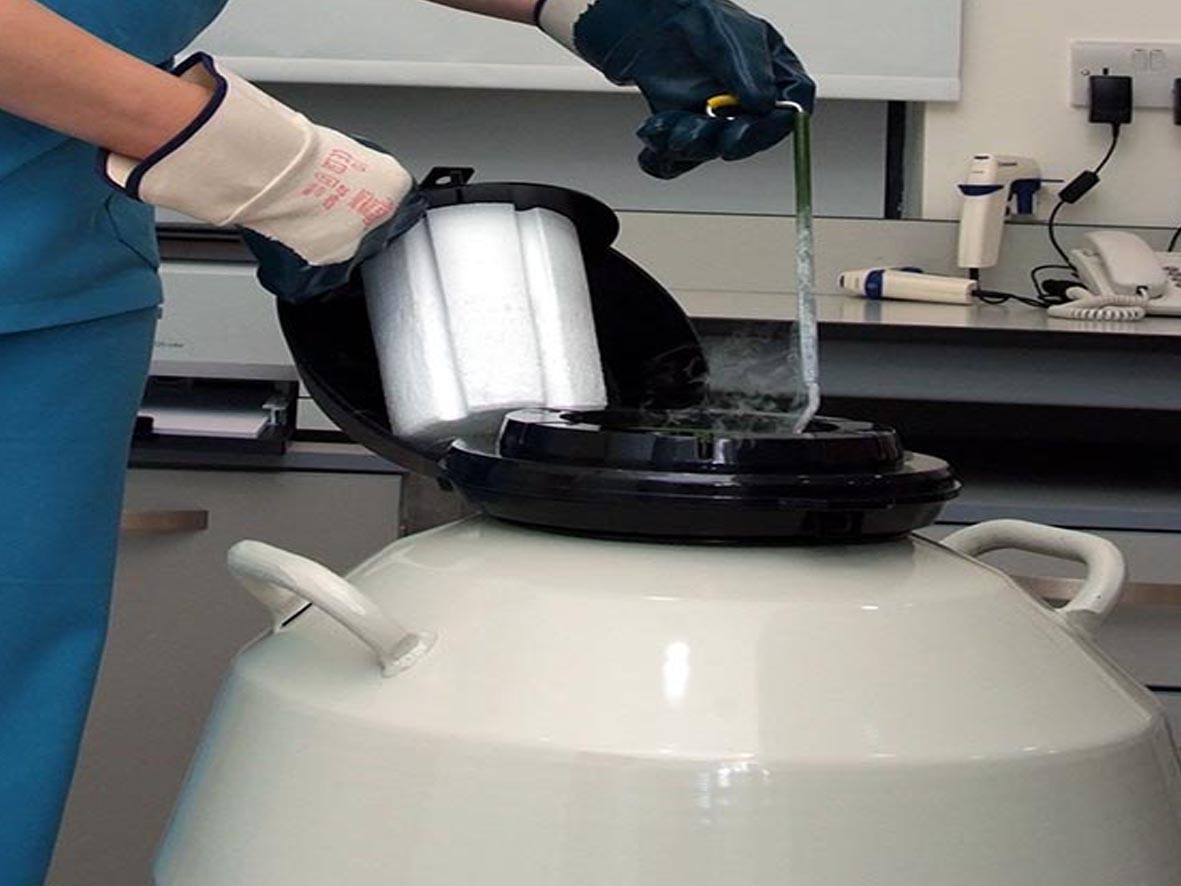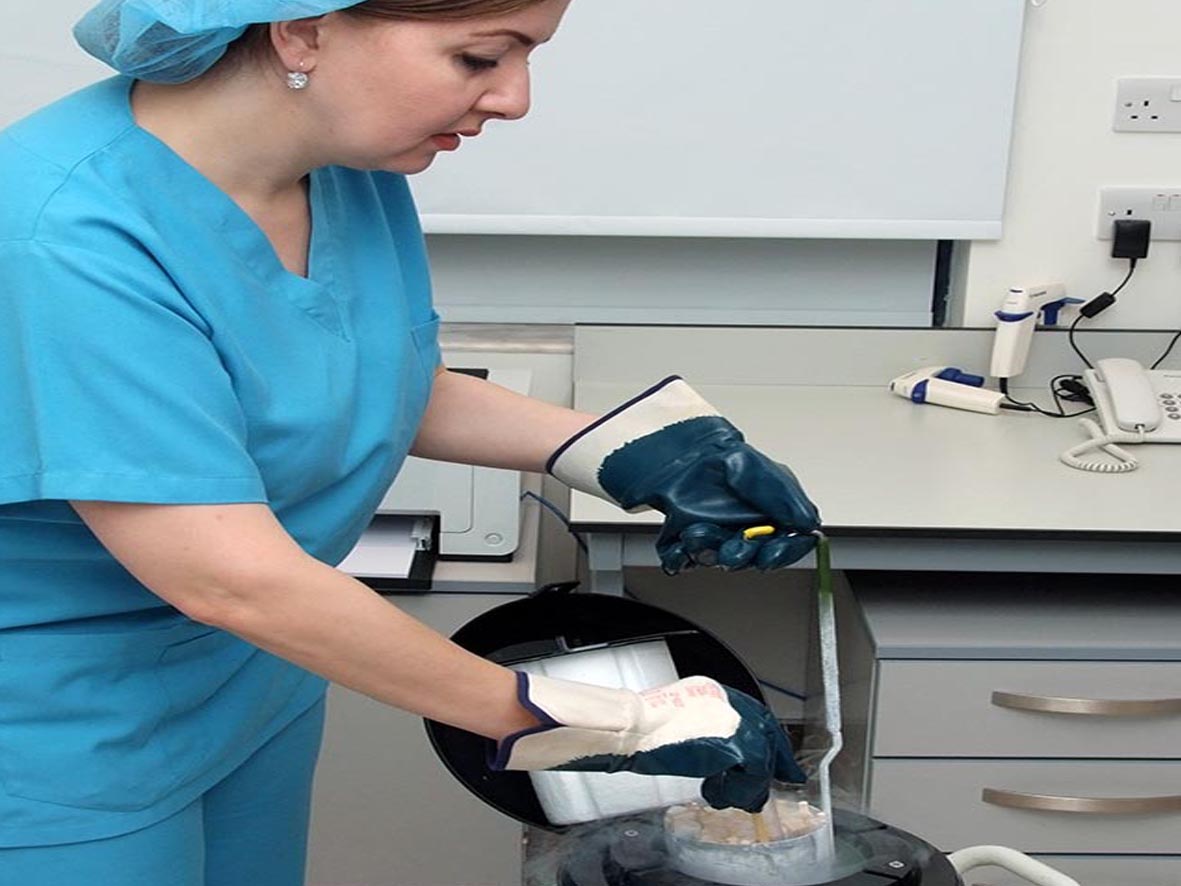A. Sperm and / or testicular tissue (from biopsy of the testes).
B. Embryos.
C. Ova (Eggs).
The freezing process is done under very strict conditions. The living cells are preserved in special solutions at very cold temperatures
(-196°C).
80% of such cryopreserved cells remain viable for future use which can reach up to 10 years if the parents wish.
Who benefits from the freezing program?
A. Freezing sperm and testicular tissue.
1. The people who benefit from this program are men diagnosed with cancer who are about to undergo chemotherapy or radiotherapy or both.
Men who have testicular disease for whom surgical removal of the testes must be performed.
Men whose sperm number and motility is severely reduced or in the case of the total absence of sperm from the seminal fluid but who have some sperm in the testes. In such cases, a biopsy of the testis is taken to search for sperms within the testis.
If sperms are found they are preserved by freezing, to be used later in ICSI. This will have saved the husband from undergoing several operations to obtain sperm.
2. Men whose work prevents them from being present during the fertilization process.
3. Men who have difficulty in providing a sample when needed on the insemination date.
B. Freezing of embryos.
The wife benefits from this program. She can use the embryos whenever she wants without having to go through the treatment process again or to undergo further operations.
C. Freezing of Oocyte.
Human oocyte cryopreservation (egg freezing) is a novel technology in which a woman’s egg (oocyte ) are extracted, frozen and stored. Later, when she is ready to become pregnant, the eggs can be thawed, fertilized, and transferred to the uterus as embryos
1. Women who are diagnosed with cancer and have not yet begun chemotherapy or radiotherapy. Egg freezing offers these women the chance to preserve their eggs so that they can have children in the future.
2. Women who would like to preserve their future ability to have children, either because they do not yet have a partner, or for other personal or medical reasons or the purpose of education, career or any other reasons.
Freezing eggs at an early age may ensure a chance for a future pregnancy.
3. Women with a family history of early menopause
4. Women who are undergoing IVF procedure and for Medical or Sycological reasons couldn’t retrieve their husband’s sperms at the day of the egg retrieval.
Method:
The egg retrieval process for oocyte cryopreservation is the same as that for in vitro fertilization. This includes hormone njections that stimulate ovaries to ripen multiple eggs. When the eggs are mature, a medication to trigger ovulation is given and the eggs are removed from the body using an ultrasound guided needle through the vagina. The procedure is usually conducted under sedation. The eggs are immediately frozen.
When a frozen oocyte is thawed for the purpose of producing an embryo, it must be fertilized by injecting it with sperm, also called intracytoplasmic sperm injection, (ICSI) because freezing may lead to hardening of the shell of the oocyte making it difficult for sperm to penetrate the shell. After the thawed oocyte is fertilized, it is treated in a manner similar to that used in the IVF laboratory for non-frozen fertilized oocytes. Any thawed oocyte which does not appear to be viable will not be inseminated.
Cryopreservation itself has always played a central role in assisted reproductive technology. With the first cryopreservation of sperm in 1953 and of embryos thirty years later, and recently the ability to freeze eggs all these procedures added a new chapter in the life of people or couples who had conception difficulties and made their life much easier, promising, and reliable.
It’s important here to mention that all freezing procedures don’t affect the health of pregnancies as; two recent studies showed that the rate of birth defects and chromosomal defects when using cryopreserved oocytes is consistent with that of natural conception.
Nowadays these techniques have become routine, and there is more to come………….








